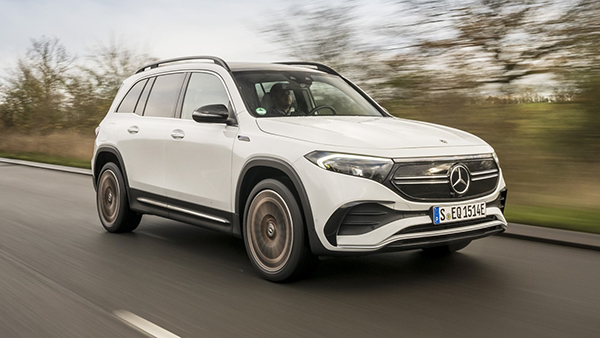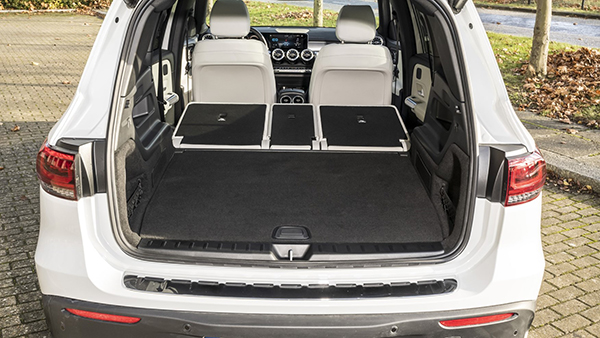If you want an electric car but needed to carry more than five passengers, your choice has been limited until now. You could have one of a few vans with seats – such as the Nissan e-NV200, the Mercedes EQV or your pick of what seems like 60 different Stellantis variants like the Peugeot e-Traveller. Or you could have a Tesla Model X.

But now there’s a new option in the form of the Mercedes EQB. It’s the all-electric version of the GLB (not the B-Class mini-MPV – try and keep up) and as such takes the form of a boxy seven-seater SUV. It’s not too vast, being a little longer but narrower than a Land Rover Discovery Sport, but packs in a 66.5kWh battery pack giving it a WLTP range of 260 miles.
We’ve taken to the road in a left-hand drive German-spec car with only five seats, but all UK cars will have the third row as standard. Stiff competition is just over the horizon, though – soon, Tesla will offer its Model Y SUV with seven seats, so the EQB has a tough fight on its hands.
How different is this to the regular GLB?
We’re surprisingly fond of the standard combustion-powered GLB here – it’s practical, fashionable and surprisingly affordable on finance or lease. It’s so good our sister site, Parkers.co.uk, awarded it Best Medium Family Car last year.
So it’s a good thing that the EQB doesn’t really change too much. Exterior changes come in the form of a blanked-out grille and new lighting patterns – like the EQA and EQC, it features full-width light strips front and rear.
Our test model also came with rose-gold accenting, notably on the intricate alloy wheels but also on the key. Fun.
The interior, meanwhile, is virtually unchanged, which means it’s similar in character to not just the EQA but the whole A-Class range.

What about the powertrain?
The aforementioned 66.5kWh battery pack sits underslung, with its frame taking on the structural duties formerly provided by chassis crossmembers. It’s paired to an electric motor on each axle, giving the EQB four-wheel drive.
There will be two variants from launch – the 300 and the 350, producing 225bhp and 288bhp respectively. But a single-motor option will arrive later, providing less performance but a longer range.
On the topic of range, both models are quoted with up to 260 miles WLTP. Our time with the car wasn’t long enough to confirm this but despite the freezing weather and persistent rain we only lost around 10 miles more range than the trip computer predicted. That’s not a bad range, and it’s on par with most electric SUVs, but pales next to the Tesla Model Y and its 315-mile WLTP figure.
As for charging, expect a full charge overnight if you’re topping up at home. When out and about the EQB’s max charge rate is 100kW, which isn’t the fastest but can still take it from 10-80% in a little over 30 minutes.
What’s it actually like to drive, though?
Performance is as strong as you’d expect. The EQB 350 we drove will do 0-62mph in 6.2 seconds, and though top speed is limited to just 99mph it’s very comfortable accelerating up to and holding motorway speeds.
Putting it into Eco mode dulls the throttle while Sport makes it hyperactive – we stuck in Comfort for most of it. You can also dial up the regenerative braking for a seamless one-pedal drive, or dial it down if you’d rather brake yourself. Whichever you choose, it’s fairly smooth and the brake pedal isn’t as mushy as some rivals.
Don’t expect the last word in dynamic excellence regardless of what driving mode you’re in. The EQB is a tall car and rolls a fair bit in the corners, while its steering is light and uncommunicative.
You will enjoy excellent comfort levels, though. Our test car rode on 20-inch wheels yet still ironed out all but the biggest potholes. Refinement is a strong point, too. The lack of engine noise can really highlight wind and road roar in an EV, but it’s all well-suppressed in the EQB.

How practical is it?
First off, it’s not going to be a permanent seven-seater. Just like the Discovery Sport or indeed the regular GLB, those third-row seats will be there for occasional use by kids or smaller adults.
Accessing them is tricky, but once back there anybody underneath about 5’6” should be able to get fairly comfortable. The second row slides, too, so you can balance legroom between all five rear passengers to make sure everybody’s as comfortable as possible. Better yet, the third row features Isofix mounting points, so you could have as many as four child seats in the rear of the GLB.
Boot space is negligible with all three rows up – in five-seat mode you get a decent but not class-leading 465 litres. With both rear rows folded, though, it’s a massive 1,320 litre space with a flat floor. And the EQB can even tow up to 1,800kg.
Up front, it’s the same dashboard as you’ll find on any Mercedes A or B model. That means a slick design based around two large screens, with your choice of touchscreen or touchpad to navigate them. The EQB gets an older design of steering wheel with some physical switches rather than touch-sensitive ones, which we like.
Equipment’s generous but making the Driving Assistance Package a £1,495 option seems stingy.
Verdict
The Mercedes EQB is exactly the kind of practical, flexible car that could help family buyers go electric. Sure, you’d enjoy more space for adults in something like an EQV, but the flavour of the month is SUV, not MPV.
It feels as though the single-motor, long-range version may make more sense, hopefully topping 300 miles on a charge, but even as it stands the EQB offers a decent range and comfortable drive. And it’s not even too expensive, undercutting the Tesla Model Y by a couple of grand. We’ll wait for UK models to be sure, but the EQB looks seriously promising.
Mercedes-Benz EQB A Practical Electric Niche-Buster
01/10/2023
No Comments
Mercedes-Benz | Mercedes-AMG
Click to rate this post
[Total: 1 Average: 5]